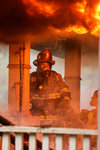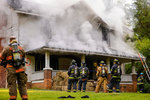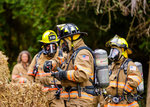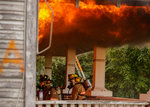




SILER CITY — Firefighters from across Chatham County gathered at a house off Alston Road early Saturday morning. But those witnessing the smoke billow from the two-story, century-old house were there not as first responders, instead serving as trainees and participants in the first of two live burns held by Siler City Fire Department this fall.
A live burn serves as a training opportunity to prepare firefighters for the reality of tackling a house fire. Firefighters, both volunteers and paid staff, met at the town’s fire department early Saturday before heading to the house that had been donated by a local family in the town.
David Reeves, a fire rescue instructor with the department, said oftentimes, residents already looking to demolish their homes will work with fire departments to use it for live burn training.
“It’s a lot cheaper to do it this way,” Reeves said. “And if we can get training out of it, then it’s a two-fold thing.”
Participants in the live burn ranged from junior volunteers under the age of 18 who were only allowed to observe the fire to longtime firefighters with years of experience in the field who actually entered the home. Aside from Saturday’s live burn, the Siler City Fire Department plans to hold another controlled burn this year in October.
The frequency with which live burns are held often depends on whether someone in the community has an older home that they are looking to donate, Fire Chief Scott Murphy said.
The process of donating a home requires a level of coordination. From the family approaching the department to the day of the live burn, the process took around two months, according to Murphy.
The department must obtain a permit through the state to pollute the air for the purposes of the training and the house must be inspected for asbestos. The North Carolina Office of State Fire Marshal also runs a N.C. Live Fire Instructor Program, a five-year process for live fire instructors to receive proper permits.
Shannon Monteiro is the owner and a member of the family which resided in the home. Several other relatives, many of whom had lived in the house for years, came to watch the burn, sitting in lawn chairs nearby and video calling others in to see. Monteiro said the family plans to put a new house on the same property; two of her nephews, incidentally, work in the fire department.
“It’s nice that we were able to do it like this, for them to be able to train in,” Monteiro said. “But it’s just hard [to see].”
A number of different departments surrounding the county were present at Saturday’s controlled burn, including those from Pittsboro, Silk Hope, Bonlee, Bennett and Colridge. Though it’s not necessarily a requirement for all the department’s firefighters to undergo a live burn training, Murphy said interior firefighters are required to attend controlled burns. The department also sends staff to programs at community colleges in the nearby area, like Central Carolina Community College, Randolph Community College and Guilford Technical Community College, that have fire control classes.
Still, Murphy says the experience of witnessing a live burn at a house offers something unique in terms of the educational experience as opposed to participating in a controlled burn in a building made from concrete blocks that holds heat differently.
“It is valuable for us to show them fire behavior, how fire builds, and then how we can go in and put it out,” Murphy said.
Reeves, the fire instructor who also served as accountability officer for the burn on Saturday, echoed that sentiment. Reeves used to teach courses at Guilford Technical Community College and said he’s seen dozens of live burns.
“It’s such an absolute, irreplaceable, valuable learning experience for the students, simply because we can do it in a controlled manner,” he said.
Forty-two individuals showed up to participate in the live burn on Saturday. In five crews led by a certified instructor, firefighters went into the home group by group to put out the fire after it was set and reset by the appropriate staff. Other staff monitored the perimeter of the site, watching in case temperatures climbed too high or the fire looked to spread in unmanageable ways.
The department tries to avoid holding burns during hotter months of the year, as temperatures inside the home may reach between 1,200 and 1,400 degrees Fahrenheit, Murphy said. The department responds to about 560 calls in a year, and average around 15 to 20 fire calls, according to the fire chief.
“We’re not the busiest department in the county; North Chatham and Pittsboro run more calls than we do,” Murphy said. “But I think we probably run more house fires than most of them just because of our density and population.”
Last year, Siler City’s fire department was awarded one of North Carolina’s best fire suppression ratings and the best score it had received in the last three decades. The rating represents the department’s general preparedness.
“Most rural departments (fall) into the 9S category,” N.C. Insurance Commissioner and State Fire Marshal Mike Causey said in a press release at the time. “While lower ratings do not necessarily indicate poor service, a higher rating does suggest that a department is overall better equipped to respond to fires in its district.”
When it comes to fire safety for civilians, Murphy said smoke detectors are key.
“You’d be shocked at how many smoke detectors we put up,” Murphy said. “That you go in the house and the smoke detectors there, but there’s no battery.”
He highlighted the “Get Alarmed Chatham County” program, which offers free smoke detectors to residents.
Siler City Fire Department’s next live burn will be on Oct. 1 at 822 North Chatham Ave.
Reporter Maydha Devarajan can be reached at mdevarajan@chathamnr.com and on Twitter @maydhadevarajan.